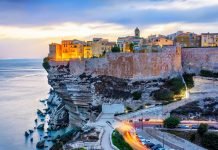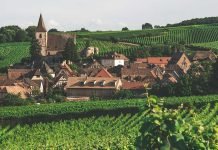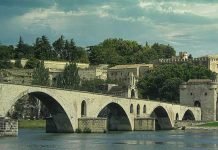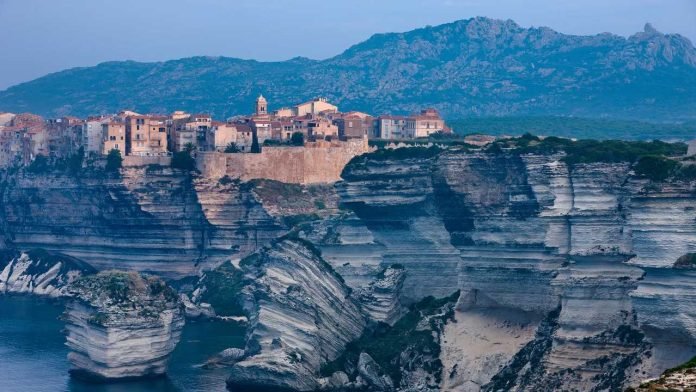From its soaring peaks to its dazzling coastline, its age-old towns to its vibrant festivals, Corsica embodies the quintessence of Mediterranean charm. The island’s unique blend of French and Italian influences, set against a backdrop of incredible natural beauty, makes it a must-visit destination. Corsica doesn’t just offer a trip; it promises a full-bodied experience, awakening the senses, and leaving visitors with unforgettable memories. In the heart of the Mediterranean, the Corsican enigma waits to be explored, one mountain trail, historical site, and mouthwatering meal at a time.
Highlights of Corsica
- Majestic mountain ranges of Monte Cinto and Monte Rotondo in the heart of the island.
- The breathtaking coastal beauty of Calvi, Bonifacio, and Porto-Vecchio.
- The historic and culturally rich towns of Ajaccio and Bastia.
- The captivating turquoise waters and white sands of Palombaggia Beach.
- The rugged wilderness and biodiversity of Regional Natural Park of Corsica.
- Traditional Corsican cuisine, a delightful blend of French and Italian influences.
- Exceptional local wines from Patrimonio and Sartène regions.
- Fascinating prehistoric sites such as Filitosa.
- Impressive architectural landmarks like the Citadel of Calvi and Bonifacio.
- The unique Corsican polyphonic choral tradition.
Majestic Mountain Ranges
Corsica, known as the “Mountain in the Sea,” boasts some of Europe’s most rugged and breathtaking mountain landscapes. Monte Cinto, the island’s highest peak, is an awe-inspiring sight to behold, its jagged silhouette dominating the skyline. On clear days, its summit offers unparalleled views over the Corsican landscape, the Tyrrhenian Sea, and even as far as Italy’s peninsula.
Monte Rotondo, another significant peak, is a haven for outdoor enthusiasts. Its complex network of trails provides trekkers with a diverse range of experiences, from easy strolls to challenging climbs. A hike to its summit, though strenuous, is richly rewarded with panoramic vistas of the surrounding mountains and valleys.
The Restonica Valley, nestled between Monte Cinto and Monte Rotondo, offers dramatic glacial landscapes, with crystalline lakes tucked away among the peaks. The valley is also a gateway to the island’s stunning mountainous heart, a must-visit for any adventure lover.
Stunning Coastal Beauty
Corsica’s coastline is a remarkable fusion of pristine beaches, rugged cliffs, and charming coastal towns. The northern town of Calvi, with its famed crescent-shaped bay and towering citadel, offers a perfect blend of historical intrigue and beach-side relaxation. The cobblestone streets and quintessential Corsican eateries make it an enticing destination for all visitors.
On the southern tip of the island lies Bonifacio, a town that seems to defy gravity with its buildings perched precariously on white limestone cliffs. The chalky cliffs provide a stunning contrast to the azure Mediterranean waters, creating a truly unique seascape. The town’s labyrinthine old quarter, punctuated with historical landmarks, adds to its charm.
Further north, Porto-Vecchio offers another delightful coastal experience with its bustling marina and impressive fortifications. The nearby Palombaggia Beach, with its turquoise waters and fine white sands, is considered one of the most beautiful beaches in Europe, inviting visitors to relax and soak in the Mediterranean sun.
Regional Natural Park of Corsica
Covering more than 40% of the island, the Regional Natural Park of Corsica is an expansive natural playground teeming with endemic wildlife and plant species. The park’s diverse ecosystems range from snow-capped mountains to dense forests, verdant valleys, and remote moorlands.
The park’s crown jewel is the GR20 trail, known as one of Europe’s toughest long-distance walks. Traversing Corsica’s spine, it promises spectacular and varied landscapes for the adventurous spirit. Its dramatic ascents and descents are a true test of stamina, but the breathtaking views make every step worthwhile.
The park is also a sanctuary for rare wildlife. The Corsican Nuthatch, a bird found nowhere else in the world, flutters among the laricio pines. Similarly, the Corsican Red Deer, once extinct but now reintroduced, roams the forests. The park’s commitment to biodiversity preservation makes it an essential destination for any nature lover.
Rich Historical Towns and Cultural Attractions
Ajaccio and Bastia
Ajaccio, Corsica’s capital and the birthplace of Napoleon Bonaparte, is a city that wears its history with pride. The grandeur of Maison Bonaparte, the ancestral home turned museum, tells tales of Napoleon’s journey from Corsican outsider to French emperor. The city’s old town, with its narrow winding streets and baroque architecture, is a living testament to the city’s past.
A visit to the Ajaccio Cathedral, a grand structure of the Renaissance era, offers a serene break from the bustling city life. The cathedral, where Napoleon was baptized, houses various works of religious art and commands an impressive presence in the city’s landscape.
On the other side of the island lies Bastia, the former capital, which enchants visitors with its distinct charm. The city is divided into two main quarters: Terra Nova (the new town) and Terra Vecchia (the old town). Terra Nova, home to the imposing Citadel, offers panoramic views of the old port and the Mediterranean. Meanwhile, Terra Vecchia, with its narrow lanes and old houses, captures the city’s authentic Corsican spirit.
Prehistoric Sites
Corsica’s prehistoric sites transport visitors thousands of years back in time. The island was inhabited as early as the Mesolithic era, leaving a rich legacy of ancient sites to explore. The most famous of these is Filitosa, a UNESCO World Heritage Site dating back to 3300 BC. The site’s menhirs – large standing stones carved into the shapes of armed warriors – bear witness to the island’s ancient inhabitants.
Filitosa is not just a historical site but a deeply spiritual place, too. The carved stones are believed to represent ancestral figures or gods, giving us a glimpse into the beliefs and traditions of the island’s prehistoric inhabitants.
Just as intriguing are the prehistoric sites of Cauria and Palaghju. Cauria’s alignment of standing stones and Palaghju’s stone circle are among the most significant Megalithic sites in the Mediterranean. Their exact purposes remain shrouded in mystery, adding to their allure.
Architectural Wonders and Unique Traditions
Corsica’s rich history is reflected in its architectural wonders. The Citadel of Calvi, with its imposing fortifications, bears testament to the island’s strategic importance and tumultuous past. From its walls, one can appreciate panoramic views of
the vibrant city and the azure Mediterranean. The citadel also houses the Cathedral of St. John the Baptist, a majestic edifice steeped in history and local folklore.
Similarly, the cliff-perched town of Bonifacio boasts its own citadel that bears the marks of Genoese and French occupations. Walking through its narrow, winding streets evokes a sense of stepping back in time, each corner revealing another stunning vista or a piece of the town’s layered past.
Corsica’s churches also offer a glimpse into the island’s architectural prowess and spiritual life. The Church of St. Jean Baptiste in Bastia, with its towering twin bell towers, stands as a prominent Baroque masterpiece. The interiors, illuminated by natural light filtering through stained-glass windows, house a rich collection of religious artworks.
But it’s not just the architecture that makes Corsica unique; it’s also its traditions. Music has a special place in Corsican culture, particularly the polyphonic choral tradition. This a cappella style of singing involves complex harmonies and soulful melodies, typically performed by a small group. The music is deeply entwined with the island’s history and identity – a testament to Corsica’s enduring spirit and its resistance to cultural assimilation.
Corsican festivals, like the ‘A Fiera di u Casgiu’ cheese festival in Venaco or the ‘Fiera di a Castagna’ chestnut festival in Bocognano, offer another slice of local culture. These lively events celebrate Corsican produce and craftsmanship, filling the streets with music, dancing, and culinary delights.
A Feast for the Senses
Traditional Corsican cuisine is a perfect marriage of the island’s unique geography and cultural influences from France and Italy. Fresh, locally sourced ingredients are at the heart of every Corsican dish. The island’s fertile soil produces a variety of fruits and vegetables, while its surrounding waters offer an abundance of seafood.
Cheese lovers will be in heaven on Corsica, especially with the island’s famous ‘brocciu.’ This versatile sheep’s milk cheese is used in a variety of dishes, from savory meals to sweet desserts. Another staple is the ‘aziminu,’ a Corsican version of bouillabaisse, that uses fresh rockfish, eel, and lobster to create a hearty, flavorful soup.
No discussion of Corsican cuisine would be complete without mentioning its charcuterie. The island’s dry, mountainous terrain is perfect for curing meats, and recipes have been passed down through generations. The ‘figatellu’ (smoked and seasoned liver sausage) and ‘lonzu’ (cured pork loin) are must-try delicacies.
Corsica is also well-known for its wine. The island’s diverse microclimates and soils contribute to the creation of unique wines, from the robust reds of the Patrimonio region to the aromatic whites of Sartène. Wine tours across the island offer an immersive experience, with opportunities to meet local vintners, explore vineyards, and, of course, taste a variety of wines.
The island’s desserts are not to be overlooked either. Chestnuts, a key Corsican product, are used in a variety of sweet treats, including the famous ‘Fiadone,’ a fluffy cheesecake-like dessert that is irresistibly tangy and sweet. Additionally, Corsican honey, a product of the island’s diverse flora, is prized throughout France for its unique flavor profiles, from woody ‘maquis’ honey to sweet chestnut honey.
Corsican gastronomy isn’t just about food and drink; it’s about celebrating the island’s unique landscape, its rich history, and its cultural influences. Whether you’re indulging in a hearty Corsican meal at a family-run ‘gîte’ or savoring a glass of local wine as the sun sets over the Mediterranean, the island’s gastronomic offerings are a journey for the senses.


















